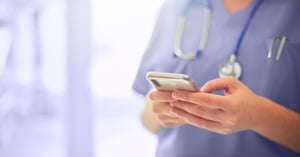Text messaging often serves as a distraction. And distractions, in general, increase the risk of patient injury.1 Whether work related or personal, texting generally involves cognitive, visual, and manual tasks. Like phone calls; pages; alarms; and colleague, patient, and patient family requests, text messaging increases the already immense amount of information received and processed during patient care.2
For example, consider the facts of a case discussed on the Agency for Healthcare Research and Quality’s WebM&M website: A physician was using her cellphone to enter an order to stop anticoagulation therapy. Before completing the order, she received a text message about a party. She responded for the party but forgot to finish the patient order. As a result of over-anticoagulation, the patient required emergency open-heart surgery.3 To the extent healthcare team member text messaging shifts the focus of encounters away from the patient, it may depart from reasonable patient expectations.
In malpractice ligation, the decision to settle a case instead of defending it at trial is based on many considerations, including the circumstances surrounding the alleged malpractice. While text messaging associated with the plaintiff’s medical care may be excused by a jury, personal text messaging could be expected to reflect poorly on healthcare defendants.4 The discovery of personal text messaging during or near the plaintiff’s injury can nudge a case from one that might be defended to one that needs to be settled.
“Distracted doctoring” aside, cellphones create a barrier between caregiver and patient,2 and can decrease patient satisfaction4 Unless they are told, patients will not know if a cellphone is being used to access decision-making, drug interaction applications (apps), dosing calculators, etc.2 Patients instead may assume the members of their healthcare team are using their cellphones for personal reasons or entertainment. Take a moment to stand in the shoes of a patient in your treatment environment. If colleagues in hallways, workstations, and elevators are focused on their screens, patients may wonder whether healthcare is being prioritized.4
Risk Reduction Strategies
Many healthcare safety improvements can be traced to the aviation industry. The Sterile Cockpit Rule is a set of Federal Aviation Administration regulatory requirements that prohibit pilots from engaging in nonessential activities during critical phases of flight. The rule was specifically amended to prohibit personal cellphone use at any time during the entire flight.4 With that in mind, consider the following strategies.
Clinicians and Staff5
- Turn off cell phone notifications when you are with patients.
- Silent, airplane, and do not disturb modes can decrease the distraction of text messaging during patient care.
- If you must use your cell phone for work-related reasons (e.g., to access a dose calculator app) during patient encounters, be transparent. Tell patients how your cellphone is adding value to their healthcare.
- If you must use your cellphone to avoid missing work-related messages while on shift, select and apply specialized text message tones to work-relate telephone numbers and silence the rest.
- Designate times to check cellphone notifications when you are not with patients.
- Leave cellphones outside of the operating room with someone who can triage incoming calls and messages.
- Consider HIPAA compliance when using this strategy.
- Let your family and friends know that you cannot be instantly available while you are providing patient care.
Operations2
- Educate clinicians and staff about the dangers of distracted practice, generally and specifically related to text messaging.
- Create a policy of no personal cellphone use during patient care.
- Use simulation exercises to illustrate how text messaging disrupts medical decision-making.
- Empower members of the healthcare team to comfortably respond to and challenge each other’s inappropriate cellphone use.
More Information About Texting in Healthcare
|
References
1. Michelle Feil. “Distractions and Their Impact on Patient Safety.” Pennsylvania Patient Safety Advisory. 2013;10(1):1-10.
2. Laura Vearrier, et al. “Use of Personal Devices in Healthcare: Guidelines From A Roundtable Discussion.” Journal of Mobile Technology in Medicine (JMTM). 2018;7(2):27–34. DOI: 10.7309/jmtm.7.2.4
3. John Halamka. “Order Interrupted by Text: Multitasking Mishap.” Agency for Healthcare Research and Quality (AHRQ). 12/1/2011.
4. James E. Szalados. “Digital Distraction and Legal Risk.” In Peter J. Papadakos, Stephen Bertman, eds. Distracted Doctoring: Returning to Patient-Centered Care in the Digital Age. Cham, Switzerland: Springer International Publishing; 2017: 201-218.
5. Kevin B. O'Reilly. “Don’t Let Smartphones Distract from Care.” AMA. 1/20/2017.

